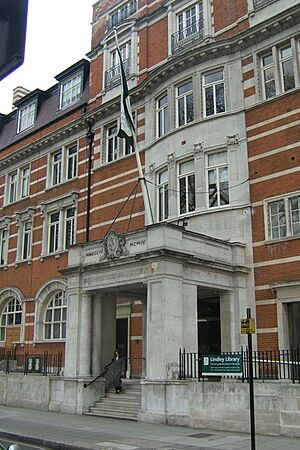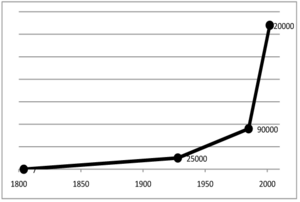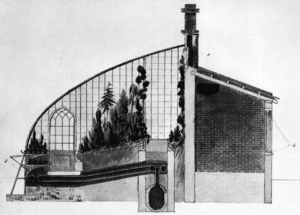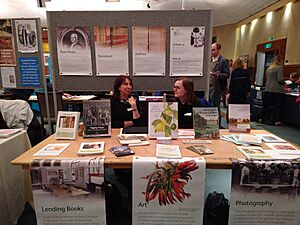Royal Horticultural Society facts for kids
 |
|
| Abbreviation | RHS |
|---|---|
| Formation | 7 March 1804 (as Horticultural Society of London) |
| Type | Registered charity |
| Purpose | Promote gardening and horticulture |
| Headquarters | London, SW1 |
|
Region served
|
United Kingdom |
|
Membership
|
414,699 (2013) |
|
President
|
Keith Weed |
|
Budget
|
2013/14 income: £71.94m |
The Royal Horticultural Society (RHS) is a big charity in the UK that helps people learn about and enjoy gardening. It started way back in 1804. The RHS works to make gardening and growing plants popular for everyone.
The RHS does many things to promote gardening. It has five amazing gardens you can visit across England. They also put on famous flower shows, like the Chelsea Flower Show. The RHS helps communities with gardening projects and offers lots of ways to learn about plants. They support both professional gardeners and people who just love gardening as a hobby. As of 2023, the president of the RHS was Keith Weed.
Contents
History of the RHS
How the RHS Started
The idea for a British gardening society came from John Wedgwood in 1800. He was the son of the famous potter, Josiah Wedgwood. John wanted a place where gardeners could meet. They would share their discoveries and talk about new ways to grow plants. He also thought the society could give awards for great gardening work.
It took four years for John Wedgwood's idea to become real. On March 7, 1804, seven men had their first meeting. It was held at a bookshop in London. John Wedgwood was the leader of this first meeting. Other important people there included Joseph Banks, who was the president of another big science group. Also present were William Townsend Aiton from Kew Gardens and James Dickson, a plant nursery owner.
Early Leaders and Goals
One important person who joined early was Thomas Andrew Knight. He became the society's president in 1811 and stayed in that role until 1838. Knight helped the society grow. He wanted it to do practical research, especially on how to breed new kinds of fruit. This focus on research helped the RHS become a leader in horticulture.
Joining the RHS
Many people are part of the Royal Horticultural Society. In 2009, there were over 363,000 members. By 2019, this number grew to more than 525,000. Today, you become a member by paying a fee. This money helps the RHS continue its work.
Some members are called "Fellows." These are people who give a larger amount of money to support the society. Members and Fellows can use special letters after their names, like MRHS or FRHS.
| Financial year | Number of members |
|---|---|
| 2013/14 | 414,699 |
| 2014/15 | 428,472 |
| 2015/16 | 448,977 |
| 2016/17 | 472,157 |
| 2017/18 | 490,205 |
| 2018/19 | 502,666 |
| 2019/20 | 525,105 |
| 2020/21 | 521,132 |
| 2021/22 | 603,458 |
| 2022/23 | 625,000≈ |
| 2023/24 | 626,000≈ |
| 2024/25 | 609,000≈ |
RHS Gardens
The RHS has five main gardens in England. These gardens are beautiful places where you can see many different plants. They are also used for research and teaching.
- RHS Garden Wisley in Surrey
- RHS Garden Rosemoor in Devon
- RHS Garden, Hyde Hall in Essex
- RHS Garden, Harlow Carr in North Yorkshire
- RHS Garden Bridgewater in Greater Manchester
The first garden the society had was in Kensington, London, in the early 1800s. Later, they had a garden in Chiswick. The Chiswick garden was used for shows and competitions.
Our Current Gardens
RHS Garden Wisley is the oldest garden the society still has. It was given to the RHS in the early 1900s. Rosemoor Garden was given to the RHS in 1988. Hyde Hall joined the RHS family in 1993. Harlow Carr became an RHS garden in 2001 when another gardening society joined with the RHS.
In 2015, the RHS announced plans for a brand new garden. This garden, called RHS Garden Bridgewater, opened in May 2021. It is located in Greater Manchester. These gardens are very popular, with millions of visitors each year.
RHS Flower Shows
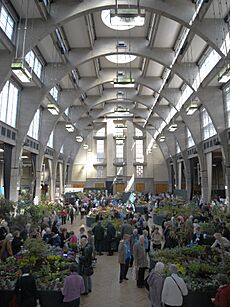
The RHS is famous for its amazing flower shows. These events happen every year across the UK. They are a chance to see incredible plant displays and new garden designs.
The most well-known show is the RHS Chelsea Flower Show. People come from all over the world to see it. Other big shows include the Hampton Court Palace Flower Show and the RHS Tatton Park Flower Show. In 2024, the RHS added more shows, like the Malvern Spring Festival and the RHS Urban Show. In 2025, the first RHS Flower Show at Wentworth Woodhouse was introduced.
The society also works with BBC Gardeners' World Live. This popular gardening event takes place every year in Birmingham.
RHS Libraries
The RHS has special libraries filled with books and pictures about plants and gardening. The main library is called the Lindley Library. It is located at the RHS headquarters in London. There are also smaller libraries at each of the five RHS gardens.
The Lindley Library has a huge collection of books. It also has an image library with thousands of original paintings and photos of plants. These images are very important for studying different plant types.
You can visit the libraries at the gardens. If you are an RHS member, you can even borrow books from the Lindley Library in London and the libraries at Wisley and Harlow Carr gardens.
Britain in Bloom Competition
In 2002, the RHS took over a competition called Britain in Bloom. This competition encourages towns, villages, and cities to make their areas beautiful with flowers and plants. It's all about improving communities through gardening.
In 2010, the RHS started a campaign called 'It's your neighbourhood'. This project helps people get involved in gardening to benefit their local community. Britain in Bloom celebrated its 50th anniversary in 2014.
Learning and Training with RHS
The RHS offers many courses for people who want to learn about gardening. These courses are for both professional gardeners and people who just enjoy gardening as a hobby. The RHS also checks and approves gardening qualifications from other places.
RHS Qualifications
- Level 1 Award in Practical Horticulture: This is a starting point for learning basic gardening skills. It's for anyone interested in plants.
- Level 2 Qualifications: These courses help people start a career in gardening or improve their skills if they already work with plants. There are separate courses for theory (learning facts) and practical skills (doing things).
- Level 3 Qualifications: These allow you to learn more deeply about specific areas of gardening. They can help you get a job or advance your career in horticulture.
- Master of Horticulture (RHS) Award: This is the highest qualification the RHS offers. It's like a university degree for gardening professionals. You can study for it over three years or more.
School Gardening
The RHS also has a special program called the RHS Campaign for School Gardening. This program gives ideas, resources, and advice to schools. It helps teachers and volunteers support students in growing plants and food. This teaches kids important life skills through gardening.
RHS Medals and Awards
Awards for People
The RHS gives special awards to people who have done amazing things in gardening.
- Victoria Medal of Honour: This is a very special award. It was started in 1897. Only 63 people can hold this medal at any time.
- Elizabeth Medal of Honour: This award started in 2023. Only 70 people can hold this medal at any time.
- Associate of Honour: This award started in 1930. No more than 100 people can hold it at one time.
- Veitch Memorial Medal: This award is given every year to people from any country. It recognizes those who have greatly helped advance gardening science and practice.
The RHS also gives Gold, Silver-gilt, Silver, and Bronze medals to people who show their plants at the flower shows.
Awards for Plants
The RHS also gives awards to plants themselves!
- Award of Garden Merit (AGM): This is the main award for garden plants. The RHS tests plants to see how well they grow and perform. If a plant does very well, it gets the AGM. This helps gardeners know which plants are good choices for their gardens.
Presidents of the RHS
The Royal Horticultural Society has had many presidents over the years. These leaders help guide the society and its goals.
- Horticultural Society of London (1804–1861)
- 1811–1838 : Thomas Andrew Knight (1st President)
- 1838–1858 : William Cavendish, 6th Duke of Devonshire
- 1858–1861 : Albert, Prince Consort
- Royal Horticultural Society (1861–)
- 1862–1883 : Duke of Buccleuch
- 1884–1885 : Sir Benjamin Thomas Brandreth-Gibbs
- 1885–1913 : Sir Trevor Lawrence
- 1913–1919 : Francis Grenfell, 1st Baron Grenfell
- 1919–1928 : Amelius Lockwood, 1st Baron Lambourne
- 1928–1931 : Gerald Loder, 1st Baron Wakehurst
- 1931–1953 : Henry McLaren, 2nd Baron Aberconway
- 1953–1961 : Sir David Bowes-Lyon
- 1961–1984 : Charles McLaren, 3rd Baron Aberconway
- 1984–1994 : Robin A.E. Herbert
- 1994–2001 : Sir Simon Hornby
- 2001–2006 : Sir Richard Carew-Pole, Bt
- 2006–2008 : Peter N. Buckley
- 2009–2010 : Giles Coode-Adams
- 2010–2013 : Elizabeth Banks
- 2013–2020 : Sir Nicholas Bacon, Bt
- 2020–present : Keith Weed
See also
 In Spanish: Real Sociedad de Horticultura para niños
In Spanish: Real Sociedad de Horticultura para niños
- Royal Horticultural Society of Ireland
- Arlow Stout, a pioneer in the hybridization of daylilies, honorary life fellow of RHS
- Lindley Hall, exhibition hall owned by the RHS and located next to their head office in London
- Robert Allen Rolfe, the founder of the magazine The Orchid Review


